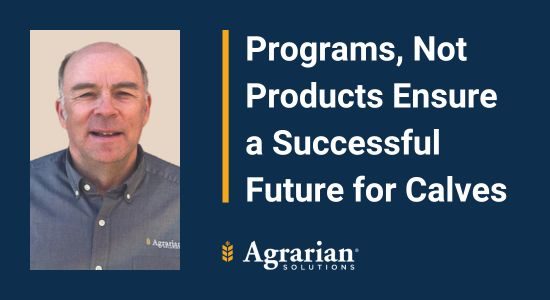Programs, Not Products Ensure a Successful Future for Calves

Written By: Larry Roth, Ph.D., PAS Vice President of Nutrition
No single product can meet all the challenges of a calf or a cow through its production cycle. Instead, a program approach of teaming products together can better support an animal over time. Agrarian Solutions has developed separate program approaches for developing calves and dairy cows.
Developing Calves
Newborn calves enter the world with a blank digestive tract, which is quickly populated by both fast-growing pathogens and slower-reproducing beneficial bacteria. Further, a calf does not receive antibodies from her mother before birth and its own immune system will not be sufficiently competent to defend against pathogens until approximately 20 d of age. From birth through weaning, a succession of pathogenic bacterium, viruses and protozoa attack the calf’s digestive tract, with each organism hoping that its predecessors have weakened the calf for the pathogens to win the war.
A successful calf management program must include colostrum for the initial defensive antibodies and growth factors. Providing beneficial bacteria, egg-based specialized proteins, and other constituents orally, in a gel, bolus, or powder form, make sure the calf receives these critical supportive factors on the decisive first day of life. From day 2 through weaning, the beneficial ingredients can be provided by mixing in the whole milk or milk replacer (MR), offering a labor savings over gel or bolus administration. However, a sick calf will likely not be consuming whole milk or MR, and we must revert to gel or bolus administration for the needed components.

Table 1 displays the Agrarian Calf Program options with three methods of providing supportive ingredients to the calf on day 1 of life: via mixing with colostrum bottle- or tube-fed; gel or bolus. Calves consuming their milk or MR will drink the supportive ingredients; however, calves off-feed will receive gel or bolus orally until resuming normal feed consumption.
